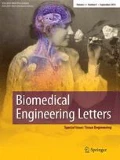Abstract
Purpose
Surface to surface registration of MR and endoscopic images is the key to MR and endoscopic image fusion, which will provide the surgeon with better 3D context of the surgical site in minimally invasive procedures. However, accurate reconstruction of 3D surface from stereo endoscopic images is still a challenging task especially for the surgical site with few features. In this paper, we propose a new method to reconstruct 3D surface from stereo endoscopic images.
Methods
We project a gridline light pattern onto the surgical site and then use a stereo endoscope to acquire two stereo images. The major steps in the surface reconstruction process include 1) applying an automatic method of detecting region of interest, 2) applying an image intensity correction algorithm, and 3) applying a novel automatic method to match the intersection points of the gridline pattern.
Results
We have validated our proposed technique on a liver phantom and compared our method with an existing method of similar scope. Our experiment results show that our method outperforms the existing method in terms of correct matching rate (98% vs. 47%) which is an indicator of the surface reconstruction accuracy.
Conclusions
The proposed technique has the potential to be used in clinical practice to improve image guidance in endoscope based minimally invasive procedures. This technique may also be applied to the endoscopic procedures of other organs in the abdomen, chest cavity and pelvis such as kidneys and lungs.
Similar content being viewed by others
References
Baumhauer M, Feuerstein M, Meinzer HP, Rassweiler J. Navigation in endoscopic soft tissue surgery: perspectives and limitations. J Endourol. 2008; 22(4): 751–766.
Feuerstein M, Mussack T, Heining SM, Navab N. Intraoperative laparoscope augmentation for port placement and resection planning in minimally invasive liver resection. IEEE T Med Imaging. 2008; 27(3):355–369.
Sonka M, Hlavac V, Boyle R. Image Processing Analysis and Machine Vision, 3rd Edition, Cengage Learning; 2008.
Prince JL, Links JM. Medical Imaging Signals and Systems, Prentice Hall; 2006.
Clements LW, Chapman WC, Dawant BM, Galloway RL Jr, Miga MI. Robust surface registration using salient anatomical features for image-guided liver surgery: Algorithm and validation. Med Phys. 2008; 35(6):2528–2540.
Maier-Hein L, Schmidt M, Franz AM, dos Santos RT, Seitel A, Jähne B, Fitzpatrick JM, Meinzer HP. Accounting for anisotropic noise in fine registration of time-of-flight range data with high-resolution surface data. Med Image Comput Comput Assist Interv. 2010; 13(Pt 1):251–258.
Groch A, Seitel A, Hempel S, Speidel S, Engelbrecht R, Penne J, Höller K, Röhl S, Yung K, Bodenstedt S, Pflaum F, dos Santos TR, Mersmann S, Meinzer HP, Hornegger J, Maier-Hein L 3D surface reconstruction for laparo-scopic computer-assisted interventions: comparison of state-of-the-art methods. Medical Imaging 2011: Visualization, Image-Guided Procedures, and Modeling, Proc SPIE 7964, 2011; 796415.
Hayashibe M, Suzuki N, Nakamura Y. Laser-scan endoscope system for intraoperative geometry acquisition and surgical robot safety management. Med Image Anal. 2006; 10(4):509–519.
Proesmans M, van Gool LJ, Oosterlinck AJ. Active acquisition of 3D shape for moving objects. Int Conf Image Process. 1996; 3:647–650.
Hu G, Stockman G. 3-D surface solution using structured light and constraint propagation. IEEE T Pattern Anal. 1989; 11(4):390–402.
Kawasaki H, Furukawa R, Sagawa R, Yagi Y. Dynamic scene shape reconstruction using a single structured light pattern. IEEE Conf Comput Vis Pattern Recogn (CVPR). 2008. 1–8.
Mountney P, Stoyanov D, Yang GZ. Three-dimensional tissue deformation recovery and tracking. IEEE Signal Proc Mag. 2010; 27(4):14–24.
Lowe DG. Distinctive image features from scale-invariant keypoints. Int J Comput Vision. 2004; 60(2):91–110.
Bouguet JY. Camera Calibration Toolbox for Matlab. http://www.vision.caltech.edu/bouguetj/calib_doc/. accessed date: May 20, 2010.
Bevilacqua V, Cambò S, Cariello L, Mastronardi G. A combined method to detect retinal fundus features. Eur Conf Emergent Aspects Clin Data Anal. 2005. 1-6.
Dey D, Gobbi DG, Slomka PJ, Surry KJ, Peters TM. Automatic fusion of freehand endoscopic brain images to threedimensional surfaces: creating stereoscopic panoramas. IEEE T Med Imaging. 2002; 21(1):23–30.
Author information
Authors and Affiliations
Corresponding author
Rights and permissions
About this article
Cite this article
Huang, X., Abdalbari, A. & Ren, J. 3D surface reconstruction of stereo endoscopic images for minimally invasive surgery. Biomed. Eng. Lett. 3, 149–157 (2013). https://doi.org/10.1007/s13534-013-0098-7
Received:
Revised:
Accepted:
Published:
Issue Date:
DOI: https://doi.org/10.1007/s13534-013-0098-7




